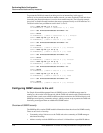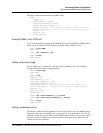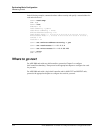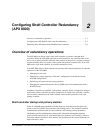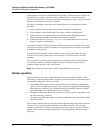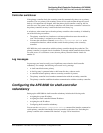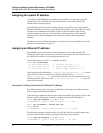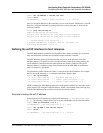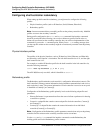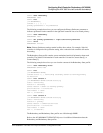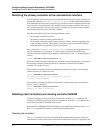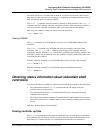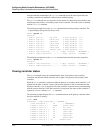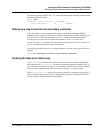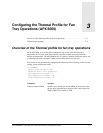
2-6 Preliminary May 9, 2000 APX 8000/MAX TNT/DSLTNT Physical Interface Configuration Guide
Configuring Shelf-Controller Redundancy (APX 8000)
Configuring the APX 8000 for shelf-controller redundancy
Configuring shelf-controller redundancy
When setting up shelf-controller redundancy, you might need to configure the following
profiles:
• Physical interface profiles (such as IP-Interface, Serial, Ethernet, Ether-Info)
• Redundancy profile
Note: Lucent recommends that you modify profiles on the primary controller only. Modified
profiles are sent to the secondary controller.
During profile configuration, the write and delete command-line interface commands
check for permission before allowing you to write or delete any profile. Profile writes or
deletes are not allowed on the secondary controller, but you can force implementation of the
commands if you use the -f command option. When you use -f, a warning message alerts
you that a profile written on the secondary might be overwritten by a transfer from the primary
controller.
Physical interface profiles
The profiles of the physical interfaces, such as IP-Interface, Serial, Ethernet, and Ether-Info,
are indexed by each controller’s slot number. The left shelf-controller slot is 41, and the right
shelf-controller slot is 42.
For example, to read the IP Interface profile for the shelf controller in the left controller slot,
enter the following command:
admin> read ip-interface { { 1 41 1 } 0 }
The APX 8000 has only one shelf, which is identified as shelf-1.
Redundancy profile
The Redundancy profile maintains each controller’s configuration information (context). The
shelf controllers exchange context information during heartbeat communications and use it to
track each other’s status. The context information for each controller is stored as an array and
is identified as Context[1] or Context[2].
Configuration of the Redundancy profile primarily involves the following subprofiles and
parameters:
• Primary-Preference is a parameter that allows the user to indicate a preference for electing
a controller as primary.
• Context is a subprofile that contains context subprofiles for both controllers, Context[1]
and Context[2].
• Context [N] is a subprofile that contains the context information for an individual
controller (Context[1] or Context[2]).
Note: Configuration of the Redundancy profile parameters must be done only on the primary
controller. Profiles written on the secondary controller can be overwritten.
Use the read and write command-line interface commands to make Redundancy the
working profile and list the Redundancy profile contents.



